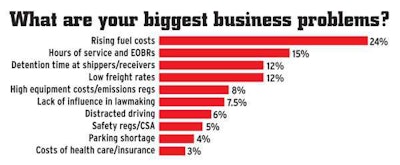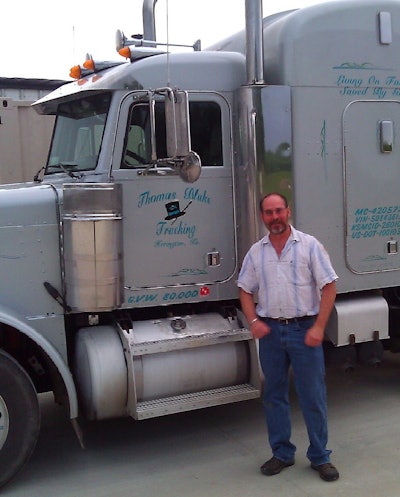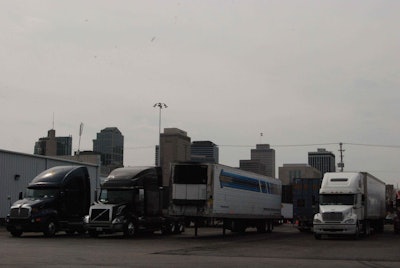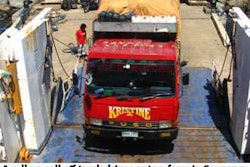
When I was gathering perspectives on potential operational, regulatory and other solutions to the top challenges for owner-operator businesses today, in addition to the top five challenges already reported on here — which you named via Overdrive polling — I asked each source to further propose fixes to a sixth industry challenge of their choosing. Below find extended excerpts from what they had to say on drivers’ professional/public image, training for new drivers, industry unity, health concerns and more.
And join me tonight with two of the sources from the reporting, owner-operator Jeff Clark and small fleet owner Tom Blake, at 7 p.m. Eastern tonight on the Truth About Trucking Live online radio show. You listen in direct online here. To call in and listen/participate in the discussion, dial 347-826-9170.

DRIVERS’ IMAGE
Small fleet owner Tom Blake

I’ve been out here a long time – since before we had cell phones and we used to talk on the CB to each other. If someone broke down on the side of the road years ago, someone would stop and help them get going. We’re missing that today. Drivers and owner-operators need to someday realize that the grass really isn’t greener on the other side. It’s better to stay put somewhere longer and build your relationships — whether with dispatchers or brokers or whoever — and it will give you so much more power.
Drivers have to get more professional. When I walk into the truck stop today, I see drivers with greasy-grimey t-shirts — we need to clean up our own image. A $15 truck-stop shirt with skulls on it is not appealing to anyone. Buy a polo for about the same money and it will project a much different image. Present yourself as a professional — we get paid to do this, and we ought to be professional about it and take care of ourselves, and maybe the perception of us will change.
If you go to a roadside scale and reek like you haven’t taken a bath in a week, and then another guy comes in clean, you’ll see a definite difference in that DOT officer’s attitude.
In his container-freight business, he added, a lot of the buyers I deal with are from China. They came here and wanted to meet me and explain the laws to them about weight in a container. I walk into a meeting dressed how I dress, and a supervisor at the company was wearing a t-shirt with no sleeves and a ponytail. The Chinese customer was asking me all the questions, even those that pertained to him, because of how I presented myself.
Advocate/driver Allen Smith
The Public perceptions of professional drivers and the lack of truth “fed” to them by the media is a huge problem. Why? Because this dictates the direction of the industry and ultimately what happens to drivers because of it, including the continuing onerous regulatory proposals.
Public perception has led to over-regulation of drivers as the general public is told that if we control/regulate drivers more, we will improve highway safety and have fewer accidents.
Smith cited the public’s belief that large trucks cause a majority of on-highway deaths and other such myths as in dire need of widespread dispelling. If we can accomplish this, then the propaganda will stop. There should more education given to the general public regarding how to drive and share the highways safely with large trucks, too.
INDUSTRY UNITY
Owner-operator Don Lanier

The governing bodies that write and interpret the laws have gotten off track. They figure we can burden the truckers with this mandate, that device, these requirements without considering how it really effects their bottom line. I see laws and such now that are simply offering my bones up to be picked clean by the sleep industry. Unnecessary regulations costing $3,000 to $5,000 per driver for tests and such because the sleep lobby wants to push through mandates and claims we’re all sleep deprived. Hogwash.
We cant use our own family doctor who graduated from Harvard because these medical-clinic chains want a monopoly on the money made from mandatory physicals, and yes some of the worst physicals I’ve ever had came form these chains. I had one recently: I was asked about 10 questions, had my blood pressure taken, my eyes checked, and the doctor sent me on my way.
At once, I was subjected to sleep apnea testing and forced to participate in an apnea screening program when the recommendations for this aren’t even finalized. I’ve since been cleared of any issue with the testing, and found the entire process much like very expensive robbery. I have started walking more, and I’ve lost weight, and yes many of us are overweight, but it doesn’t make us all unsafe!
Frankly, drivers, we need to stand up to this pickpocketing and demand some drivers be on the boards that recommend new health regs, not just PHDs and lobbyists. We need to be proactive in the rules and regs, and we need to stick up for each other. Unions may have good and bad, but without a unified voice, you’re alone against the billion-dollar lobby seeking to force you to buy, use and maintain the thing they have invested in. For me, the money I spend on OOIDA membership is worth every penny. Be involved, use your voice, write and petition congress to get what truckers need, not what’s shoved down our throats.
Landstar’s Joe Beacom
Beacom took the unity topic in a straight business direction, with an acknowledgment of the public perception problem as well.
In general, owner-operators and drivers have a tendency to be misunderstood and misrepresented. Our industry is very fragmented and the opinions, preferences and operating habits of owner-operators are often different than those of large fleets. The owner-operator’s solution lies in finding a company that has the same values, principles and priorities as they do. Do your homework, find the right fit and your biggest problem just got solved.
For the owner-operator who is not aligned with an exclusively owner-operator company, the problem is knowing if he/she is getting access to all the loading opportunities or only those that company-owned trucks were not able to transport. As an owner-operator, being treated as the backbone of the company’s capacity rather than as flex capacity that is only a short-term priority is critical.
For owner-operators who run on their own authority, the challenge can be his/her ability to manage regulatory issues, to manage cash flow due to slow-paying customers and his/her inability to obtain discounts on fuel, tires or equipment that are available to large organizations, which impacts profitability.
HEALTH
Prime’s Don Lacy
Mortality rates for truck drivers are several degrees higher than men in other industries. Prime has developed its own series of DVDs detailing exercises that can be done in and around a truck. Prime also offers sound nutritional advice and has a wellness assessment program, as well as smoking cessation programs and workout facilities in its terminals.
Lacy went on to cite the example of former Prime-leased owner-operator/champion swimmer and triathlete Siphiwe Baleka (pictured), now serving with the company as a wellness counselor — he was likewise instrumental in making that series of DVDs Lacy mentioned above — as a great example of what drivers can do with the right kind of support.
Allen Smith
For years drivers have had to deal with a difficult lifestyle: long hours, long periods away from home, lack of exercise, poor food choices and eating habits, irregular sleep patterns. This has all led to increasing prevalence of high blood pressure, diabetes, obesity, arthritis, and others.
Health, Smith says, “will be a big focus at the [second annual Truck Driver Social Media Convention] in October in Kansas City, as Rick Ash of the Trucking Solutions Group and Elaine M. Papp, Medical Programs Division Chief at the FMCSA, will be presenting.” Find more about the meeting here.
Don Lanier
I ask the truck stops to start carrying fresh fruit, install lighted walking paths around your facilities. Have a health-care provider on-site — a nurse or nurse practitioner, someone who knows where local services can be obtained.
If health is our concern, then the truck stops need to help: a little less soda, a little more green tea; less pizza, more fresh fruit; a few passive workouts like a pull-up bar, etc. Drivers might use it, and your facilities, more.
TRAINING STANDARDS
Allen Smith
This is a concern that few put high on the list. The FMCSA has failed to recognize this as a problem, likewise many of the motor carriers. Instead, it appears that increasing regulation seems to be the answer for inadequate training. Recruiters for a truck driving career continue to offer false hopes and promises. Ads of making “$60-$100,000 yearly with no skills required” draw many into the industry, who might spend as much as $10,000 for a CDL license only to find out that the school failed to tell them that they may not be hired because of medical problems, obesity or violations and felonies.
Many CDL schools have little hands-on training, and many graduates are left to learn how to drive with the company trainer. Some of these trainers are new drivers themselves with as little as three months’ experience.
Many trucking industry problems can be solved by creating standards. The turnover rate for 1st year students is near 200 percent with an extremely high first-year failure rate. The training is many times set up like a team-driving situation, the trainer sleeping while the trainee is driving. This is for nothing more than to move freight cheaply, as the new driver has been known to receive as little as 17 cents per mile.
Smith also noted lease-purchase programs with high monthly payments and insufficient mileage to make those payments as another negative aspect of the lack of training standards.
A statistic that many don’t realize is not to be found is the number of crashes involving drivers less that one year of experience. I’ve looked all over, and it’s not to be found, so what criteria is being used to determine that there is no need for improved training? Among the statistics found in the Trucks Involved in Fatal Accidents file (TIFA), there are no stats correlating fatal truck crashes associated with new driver trainees. There should be.
With carriers all up in arms about the “truck driver shortage,” you would think that better training would be their priority, especially since “quality drivers” are in demand. In the past it was acceptable to have high turnover rates and high failure rates of first year students. It kept the truck driver shortage notion alive, and a continuing stream of first-year, low-paid drivers moving freight.
Today, the truth is, companies are faced with a huge dilemma: Now that CSA is in place, they need quality drivers and safe drivers, however that means that they will need to pay higher wages, something they have not had to face.
The fact is, if you want well-trained, safe, quality drivers, you’re going to have to pay them. If not, continue to scratch your heads and try to figure out a way around it.
PARKING
Don Lanier

Allen Smith
I find that there hasn’t been an all-out attempt to solve this 20-year-old problem pretty amazing. When safety and “truck driver fatigue” is such a major focus with FMCSA, ensuring a driver’s proper rest should be their No. 1 priority in order to secure safety for the public as well as the driver. Years of research has confirmed that there is a shortage of truck parking, and yet the emphasis to resolve this issue is still not receiving the immediate attention that it deserves. Highway safety is not secured when trucks are parked on shoulders and on- and off-ramps because parking is full. This problem will be increased if EOBRs are mandated. If this problem is not immediately addressed in a timely manner, then I’m afraid we’re going to see some dangerous situations evolve.
Since my interview with Smith, an effort has been made to boost driver participation in identifying places where the parking need is greatest on the roadways. Here’s a link to a piece about Jason’s Law’s inclusion in the recent highway bill, and more about OOIDA’s own efforts.
Owner-operator Jeff Clark
Clark included me on a letter to Wisconsin officials, FMCSA reps and others regarding the blocking off of the northbound U.S. 151 weigh station near Madison, Wis. His outreach is emblematic of the kind of efforts individuals can take to improve quality of life on the roadways. No word yet on the end of this story, as the letter was sent only yesterday, but it read like this:
My name is Jeff Clark. I am a Wisconsin truck driver/owner-operator. I am also an avid runner and bicyclist. For years, I had been taking breaks in the northbound weigh station on U.S. 151 just south of Madison. It lies at the north edge of the Military Ridge state trail. The location is also at the south edge of the Madison trail system.
Now, it is blocked off, and I don’t understand why. Closing the weigh station off creates a 60-mile gap between truck parking on U.S. 151. The trail used to run along the outer edge or the parking area, which worked great. For the mountain bike enthusiast there is a single track trail about 0.5 miles from the parking area.
This would make an excellent trailhead with truck parking. It could be a sign of what could be done when the Rails to Trails Commision (I am a member), OOIDA (also a member) and government (I am a tax payer) work together.
Join us tonight on the Truth About Trucking Live show via this link, 7 p.m. Eastern, sharp.











